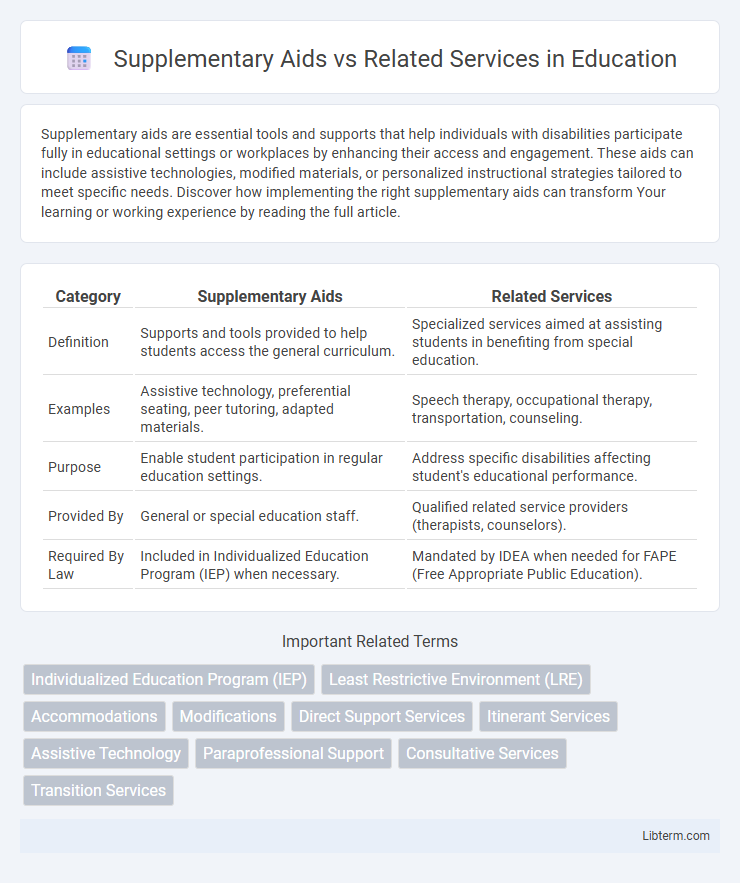Supplementary aids are essential tools and supports that help individuals with disabilities participate fully in educational settings or workplaces by enhancing their access and engagement. These aids can include assistive technologies, modified materials, or personalized instructional strategies tailored to meet specific needs. Discover how implementing the right supplementary aids can transform Your learning or working experience by reading the full article.
Table of Comparison
| Category | Supplementary Aids | Related Services |
|---|---|---|
| Definition | Supports and tools provided to help students access the general curriculum. | Specialized services aimed at assisting students in benefiting from special education. |
| Examples | Assistive technology, preferential seating, peer tutoring, adapted materials. | Speech therapy, occupational therapy, transportation, counseling. |
| Purpose | Enable student participation in regular education settings. | Address specific disabilities affecting student's educational performance. |
| Provided By | General or special education staff. | Qualified related service providers (therapists, counselors). |
| Required By Law | Included in Individualized Education Program (IEP) when necessary. | Mandated by IDEA when needed for FAPE (Free Appropriate Public Education). |
Introduction to Supplementary Aids and Related Services
Supplementary aids and services are supports provided in general education settings to help students with disabilities participate and progress alongside their non-disabled peers. Related services include specialized support such as transportation, speech-language therapy, and psychological services that address the unique needs of students requiring additional assistance. These provisions ensure access to an inclusive education by addressing both instructional and non-instructional needs in compliance with the Individuals with Disabilities Education Act (IDEA).
Defining Supplementary Aids
Supplementary aids refer to specially designed supports or services provided in the general education environment to enable students with disabilities to participate and progress alongside their non-disabled peers. These aids include assistive technology, adapted materials, or instructional modifications tailored to individual needs. Unlike related services, which encompass support like transportation or counseling, supplementary aids emphasize in-class accommodations that promote inclusion and access to the curriculum.
Understanding Related Services
Related services encompass a range of supportive activities designed to help students with disabilities benefit from special education, including transportation, speech-language therapy, and occupational therapy. These services focus on enhancing a student's access and participation in educational programs rather than supplementing classroom instruction directly. Understanding related services is essential for developing effective individualized education programs (IEPs) that address all aspects of a student's educational needs.
Key Differences Between Supplementary Aids and Related Services
Supplementary aids refer to supports provided within the general education classroom to help students with disabilities participate alongside peers, such as assistive technology or modified materials. Related services encompass specialized professional supports like speech therapy, occupational therapy, or counseling designed to assist a student in benefiting from their special education program. The key difference lies in supplementary aids being integrated accommodations and supports within the instructional environment, while related services involve distinct clinical or therapeutic interventions delivered separately from general education instruction.
Legal Framework: IDEA and IEP Requirements
Supplementary aids and related services are distinct components under the legal framework of the Individuals with Disabilities Education Act (IDEA), ensuring students with disabilities receive appropriate support. Supplementary aids refer to accommodations and supports included in a student's Individualized Education Program (IEP) to facilitate learning alongside peers, while related services encompass additional professional support such as speech therapy or transportation necessary for the child to benefit from special education. IDEA mandates that every IEP team consider and document these aids and services to comply with statutory requirements and guarantee Free Appropriate Public Education (FAPE).
Common Examples of Supplementary Aids
Supplementary aids in special education include tools and supports such as visual schedules, assistive technology devices, and preferential seating that help students with disabilities access the general education curriculum. Common examples also encompass peer tutoring, behavior management plans, and adapted materials tailored to individual learning needs. These aids are designed to enable meaningful participation alongside nondisabled peers, distinct from related services like speech therapy or transportation.
Typical Related Services in Special Education
Typical related services in special education include speech-language therapy, occupational therapy, physical therapy, and counseling. These services support students with disabilities to access the general education curriculum and participate fully in school activities. Supplementary aids, such as assistive technology or adapted materials, complement related services by providing accommodations within the classroom environment.
Determining Appropriate Supports for Students
Determining appropriate supports for students requires distinguishing between supplementary aids, which are accommodations and modifications integrated into the general education setting to enhance access and participation, and related services, which are specialized supports like speech therapy or transportation that address specific disabilities. Decisions should be based on individualized education program (IEP) assessments, ensuring that supports align with each student's unique needs to promote effective learning outcomes. Collaboration among educators, specialists, and families is essential to identify and implement the most suitable combination of supplementary aids and related services.
Collaboration Among Educators, Families, and Specialists
Collaboration among educators, families, and specialists is essential in effectively implementing supplementary aids and related services to support students with disabilities. Supplementary aids involve accommodations and supports provided within the regular education environment, requiring coordinated input from teachers and support staff to tailor interventions. Related services, such as speech therapy or counseling, depend on ongoing communication and teamwork among all parties to ensure that individual education program (IEP) goals are met and student progress is monitored consistently.
Maximizing Student Success with Tailored Supports
Supplementary aids provide in-class accommodations such as assistive technology and adapted materials that enable students with disabilities to access the general education curriculum effectively. Related services include specialized support like speech therapy, occupational therapy, and counseling designed to address individual needs beyond the classroom setting. Combining these tailored supports ensures comprehensive assistance that maximizes student success by promoting independence, engagement, and academic achievement.
Supplementary Aids Infographic

 libterm.com
libterm.com